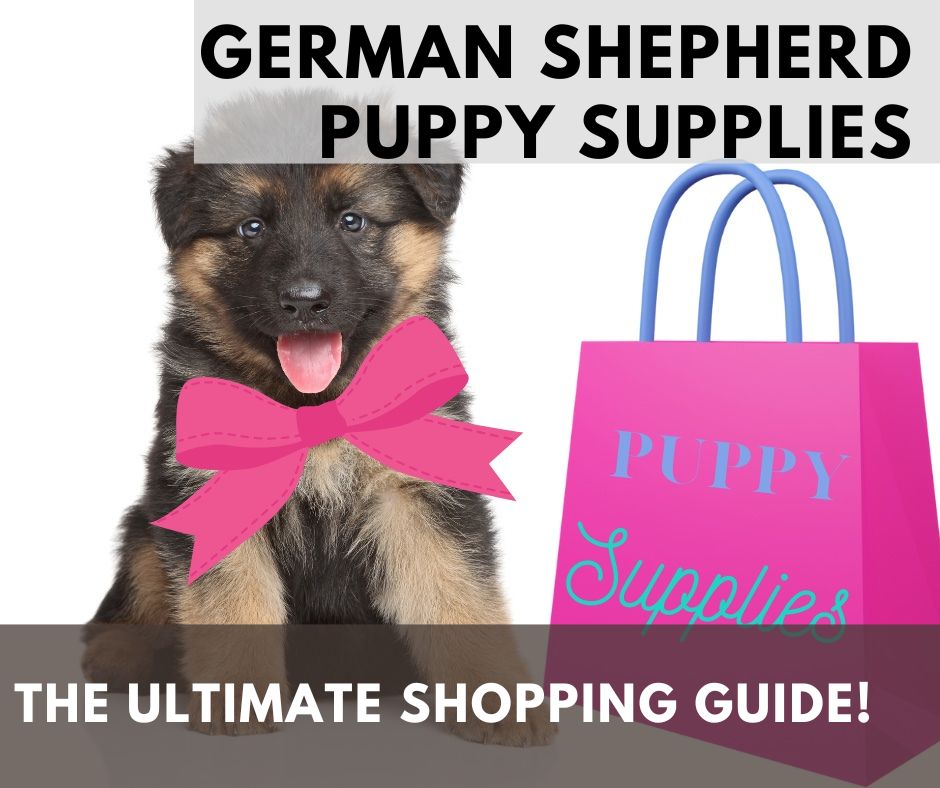Hey there, fellow German Shepherd enthusiast! If you’re reading this, chances are you’re looking for advice on German Shepherd puppy supplies because you are about to embark on an exciting journey with a brand-new German Shepherd puppy.
Congratulations on your decision to welcome this fantastic addition to your family! As someone fortunate enough to share life with these incredible companions for over two decades, I can assure you that you’re in for a world of love, adventure, and unforgettable moments. Let’s talk about the key to ensuring a smooth and joyful transition.
Bringing a German Shepherd puppy into your home is an experience like no other.
These loyal, intelligent, and charismatic dogs have a special place in the hearts of countless dog lovers, and I’m here to share my insights and tips to make this transition as smooth as possible. Whether you’re a first-time puppy parent or adding another four-legged family member, I’m here to guide you through getting your home ready for your new furry friend.
We will cover all the essential items you’ll need to welcome your German Shepherd puppy into your life with open arms. From the must-have items to the little luxuries that can enhance your pup’s comfort and well-being, I’ve got you covered.
So, let’s get started on this exciting shopping expedition together.
- Essential Supplies Checklist for Your German Shepherd Puppy
- Essential Supplies for Safety and Training
- Creating a Comfortable Home Environment
- Puppy Health, and Pet Insurance
- Behavioural Tips: Nurturing Your German Shepherd’s Well-Rounded Development
- Addressing Common Challenges: Navigating the Ups and Downs
- FAQs: German Shepherd Puppy Supplies
- Conclusion: Your German Shepherd’s Journey Begins Here
- Join the Conversation: Sharing Your German Shepherd Supply Journey
Essential Supplies Checklist for Your German Shepherd Puppy
As you prepare to welcome your brand new German Shepherd puppy into your home, having the right supplies on hand is essential for a smooth and joyful transition. To help you ensure that you’re well-prepared for every aspect of your puppy’s arrival, here’s a comprehensive checklist of must-have items to consider:-
Safety and Training Supplies:
- Collar and Identification: Choose a sturdy collar with an identification tag containing your puppy’s name and your contact information.
- Harness for Safety: Opt for a comfortable harness to ensure safe walks and minimise strain on your puppy’s neck.
- Travel Restraints: Ensure secure travel with a soft-sided travel crate or restraint for vehicle journeys.
- Leash Training Essentials: Introduce leash training early with a suitable leash for different situations.
Creating a Comfortable Home:
- Crate for Training: Select a crate of appropriate size and type to aid in housebreaking and create a safe space.
- Cosy Bedding: Provide comfortable bedding inside the crate to ensure a cosy sleeping environment.
- Puppy Gates and Play Pens: Set up puppy gates or playpens to create a secure and confined space for your puppy.
- Poop Bags and Clean-Up Supplies: Be a responsible owner by having eco-friendly poop bags and cleaning supplies ready.
Toys, Food, and Grooming:
- Choosing the Right Toys: Select a variety of durable toys to keep your puppy engaged and entertained.
- Food and Water Bowls: Opt for stainless steel bowls for feeding and hydration.
- Selecting Puppy Food: Choose high-quality puppy food with proper nutrients for growth and development.
- Treats for Training: Have nutritious treats on hand for effective positive reinforcement during training.
- Essential Grooming Supplies: Gather grooming tools like brushes, combs, and nail clippers for regular coat maintenance.
Health, Insurance, and Care:
- Regular Veterinary Check-Ups: Schedule routine check-ups for vaccinations, preventive care, and overall health monitoring.
- Importance of Pet Insurance: Consider obtaining pet insurance to handle unforeseen medical costs and create a sense of security.
Behavioural Tips and Common Challenges:
- Behavioral Tips: Familiarise yourself with socialisation, training, and enrichment strategies to nurture your puppy’s well-rounded development.
- Addressing Common Challenges: Be prepared to tackle challenges like crate training, teething, and separation anxiety with patience and effective strategies.
In the journey of welcoming and nurturing your German Shepherd puppy, ensuring their safety and providing practical training are paramount. Armed with this comprehensive checklist, you’re well on your way to creating a comfortable and enriching environment for your furry companion.
So, first up, let’s dive into exploring the essential supplies for safety and training that will set the foundation for a harmonious life together.
Essential Supplies for Safety and Training
Equipping yourself with the right tools and supplies can significantly impact your puppy’s growth and development. In this section, we’ll explore the essential supplies that play a vital role in ensuring your puppy’s safety and facilitating successful training endeavours.
Collar and Identification
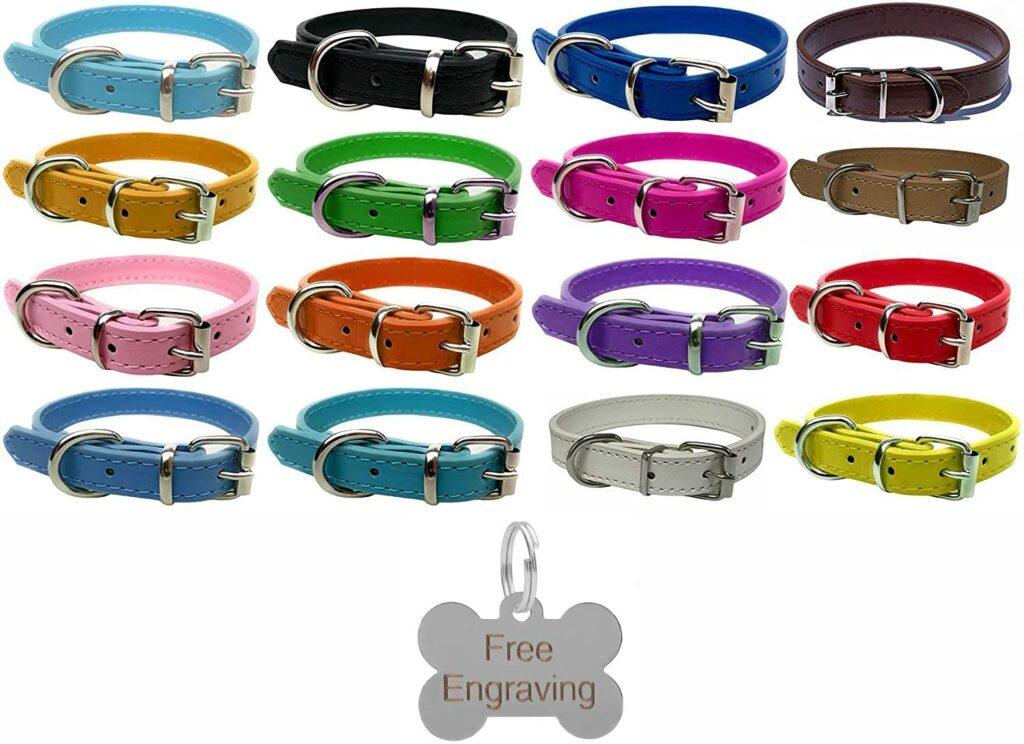
Collars and identification are not just fashion accessories; they are essential tools to keep your puppy safe and in compliance with legal requirements. When your puppy is outdoors or in public spaces, having proper identification can swiftly reunite you if they happen to wander off.
In many places, dogs must wear identification tags displaying their name, your contact information, and potentially their license.
Different collar options are available, each serving distinct purposes. You have choices from traditional flat collars to a martingale or choke collars for training. Personalisation is also a great idea. Engraving your puppy’s name and your phone number on their tag can provide an additional layer of security.
Soft leather or nylon collars are the best when your pup is young. Ensure the collar is adjustable, and check it regularly to ensure it is not getting too tight as your puppy grows. It needs to be tight enough not to slip off but not so tight that you can’t get your fingers behind it.
You can use different collars when your puppy gets older, but I recommend a soft leather or nylon one for now. I would check this every couple of days, to begin with, as your puppy will be growing extremely fast in the early days.
For more information on the importance of identification and various collar options, you can visit the AKC’s guide on dog identification for insights from a reputable authority in dog care.
Harness for Safety
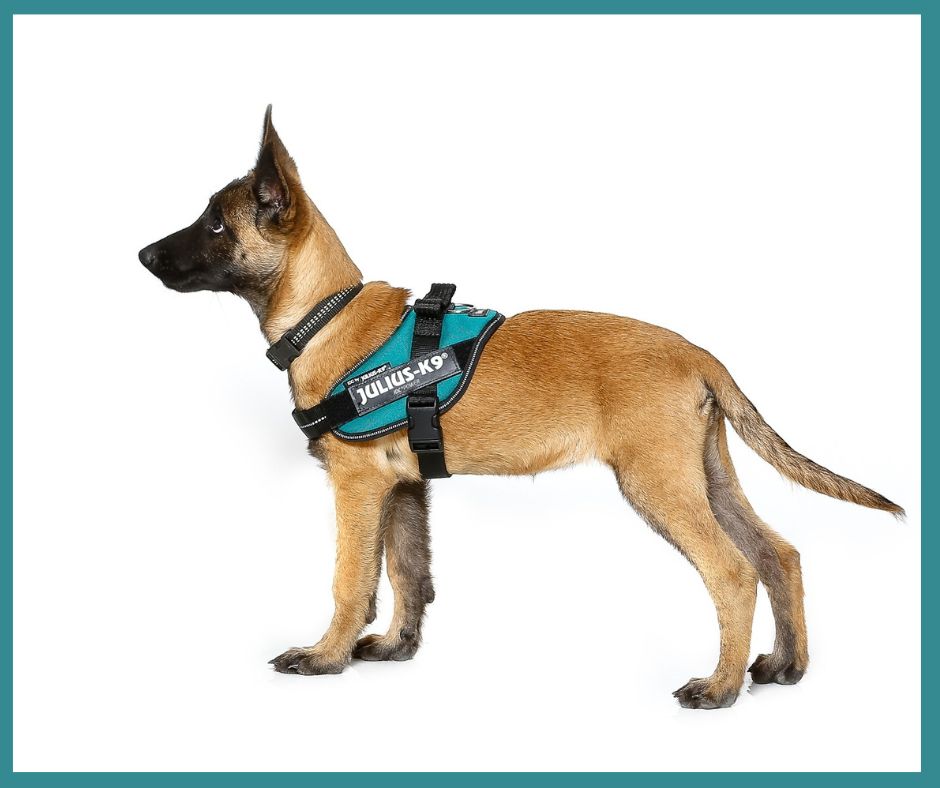
Consider opting for a harness over a collar, especially for walking and vehicle travel. Harnesses distribute pressure more evenly across your puppy’s body, reducing the risk of neck strain associated with collars. This is particularly crucial for German Shepherds, as they are known for their strong pulling tendencies.
Harnesses offer enhanced safety, preventing your puppy from slipping out and providing better control during walks. They also offer an advantage during car rides by enabling you to secure your puppy safely using travel restraints.
Case Study: Embracing No-Pull Harnesses for Strong German Shepherds
Whilst I had used harnesses when my dogs were puppies up until recently, I was hesitant about using them with adult dogs as I felt that it made it easier for them to pull.
However, Cody, my spirited and strong male German Shepherd, has changed my view. As soon as he reached about 12 months old, his pulling made walks very challenging, and despite lots of training, we never really managed to control it.
That is until his trainer recommended a “no-pull harness”. Initially, I was sceptical but pleasantly surprised at how much of a difference it made. Now I recommend this type of harness to anyone, especially those struggling with a dog who tends to pull.
To learn more about the benefits of harnesses and their impact on safety, check out the ASPCA’s guide on harnesses for a reliable source of information.
Travel Restraints
When it comes to travelling with your German Shepherd puppy, travel restraints are essential to ensure their safety during car rides. Travel crates are also a popular choice, offering comfort and security. They prevent your puppy from wandering around the vehicle, minimising distractions for the driver and reducing the risk of injury in case of sudden stops.
Alternative options include seat belt harnesses that fasten your puppy securely to a seat belt buckle. This prevents them from moving around excessively while still providing them with some mobility.
Leash Training
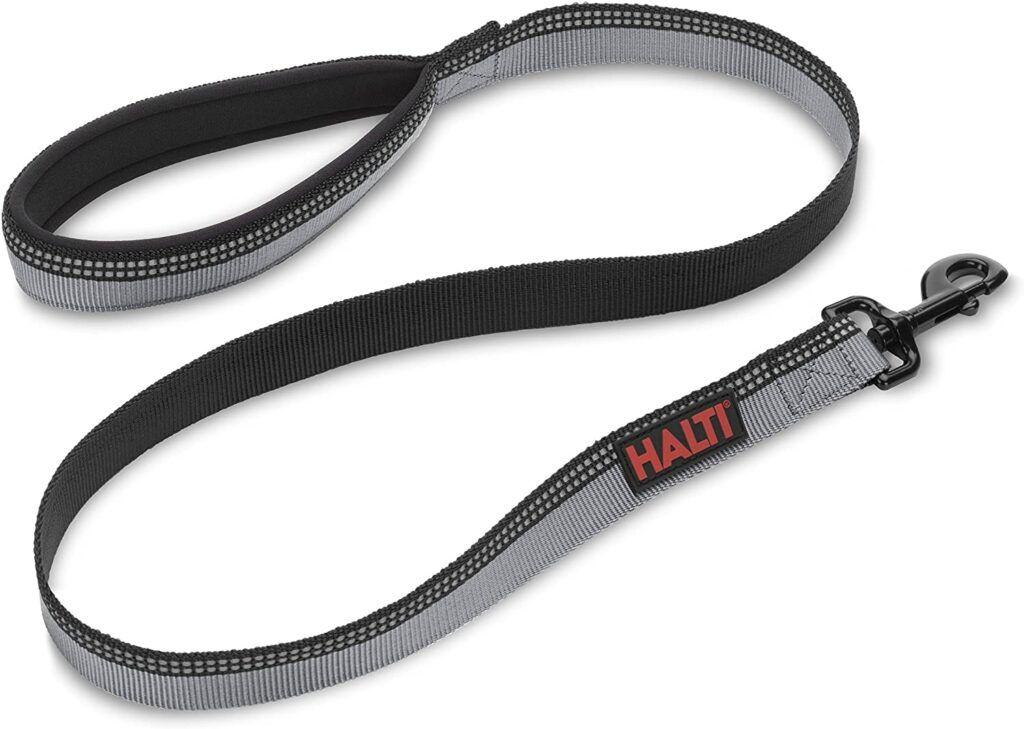
Proper leash training is essential for maintaining control during walks and ensuring your puppy’s safety. Introduce your puppy to a leash from a young age, allowing them to get accustomed to the sensation and weight. Start with short, positive sessions, gradually increasing the duration as your puppy becomes more comfortable.
Various types of leashes are available, such as standard leashes, retractable leashes, and training leashes. The choice depends on your puppy’s behaviour and your specific training goals.
Again a soft leather or nylon one is best. It wants to be 6 feet at maximum and be strong as puppies try to play with their lead, and they can also chew through them. It will be fine as long as it is well made, comfortable for you to use, and has a good clasp on it to clip to the collar.
Avoid the chain ones, as your puppy could damage its teeth if it does try to play with or chew it. Also, don’t be tempted to get a retractable one, either. I’m telling you this from personal experience as I made a mistake with my male dog, and it led to pulling problems later on.
For expert advice on leash training techniques and tips, refer to the American Kennel Club’s guide on leash training to ensure effective training sessions.
By embracing these essential supplies for safety and training, you’re setting the foundation for a strong bond with your German Shepherd puppy while nurturing their well-being and development.
Remember that a prepared owner is self-assured, capable and prepared to embark on this exhilarating journey alongside their furry companion.
Creating a Comfortable Home Environment
To provide your German Shepherd puppy with the best possible start in life, creating a comfortable and secure home environment is essential. This contributes to their well-being and lays the groundwork for effective training and a harmonious living space.
In this section, we’ll explore the essential supplies and strategies to make your home a haven for your furry companion.
Crate Training
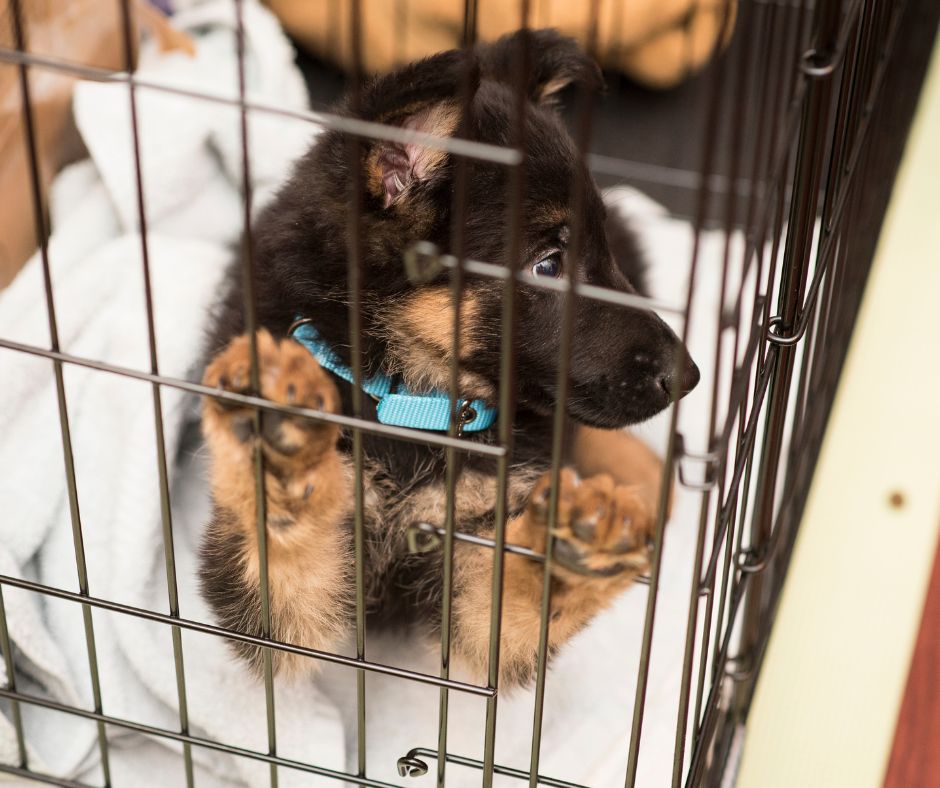
Crate training is a valuable tool for training and ensuring your puppy’s safety. A crate serves as a den where your puppy can retreat, sleep, and relax. It aids in housebreaking by promoting bladder control and minimising accidents. Additionally, crates offer a sense of security which is particularly useful during times when your puppy might feel anxious.
Selecting the right crate size and type is crucial. The crate should be large enough for your puppy to stand, turn around, and lie down comfortably. Yet, it should be moderately sized to prevent accidents. Choose a crate with a durable build and appropriate ventilation.
The soft-sided ones are not good for German Shepherd puppies. I recommend getting a metal crate that is large enough to accommodate your puppy when they are fully grown and use partitions or a cardboard box inserted inside it to make it more size appropriate whilst your puppy is small.
For most German Shepherds, you will need the 48″ size one, and you will also need some comfortable bedding or a crate mat put inside too.
It is also essential that you crate-train your German Shepherd puppy before you leave them in it.
Bedding Options

Providing a comfortable bedding option within the crate ensures your puppy has a cosy space to rest. A soft, supportive bed can alleviate joint pressure and provide a sense of security. Bedding absorbs moisture, helping maintain hygiene within the crate.
Choose bedding that is easily washable to maintain cleanliness. Some options include memory foam beds, orthopaedic mats, and machine-washable blankets. Introduce bedding gradually, ensuring your puppy doesn’t chew on or ingest it.
To learn more about the importance of a comfortable crate and suitable bedding options, refer to the American Kennel Club’s guide on crate training for expert advice.
Puppy Gates and Play Pens
Puppy gates and playpens offer a controlled and safe space for your puppy to explore. These tools are handy during the initial stages of housebreaking and training when you want to limit access to certain areas of your home.
You can use puppy gates to block stair access or to keep your puppy away from rooms with potential hazards. Playpens provide a secure area where your puppy can play, relax, and engage in various activities. These tools help prevent unwanted chewing, accidents and keep your puppy out of trouble.
Puppy Pads, Poop Bags and Clean-Up
You are going to need these for sure. Your puppy will have bathroom accidents while getting used to their new environment, so it’s a good idea to get some puppy pads and a pet deodoriser too.
Mud is also a problem as puppies like to explore puddles and dig, and if they are done together, well …
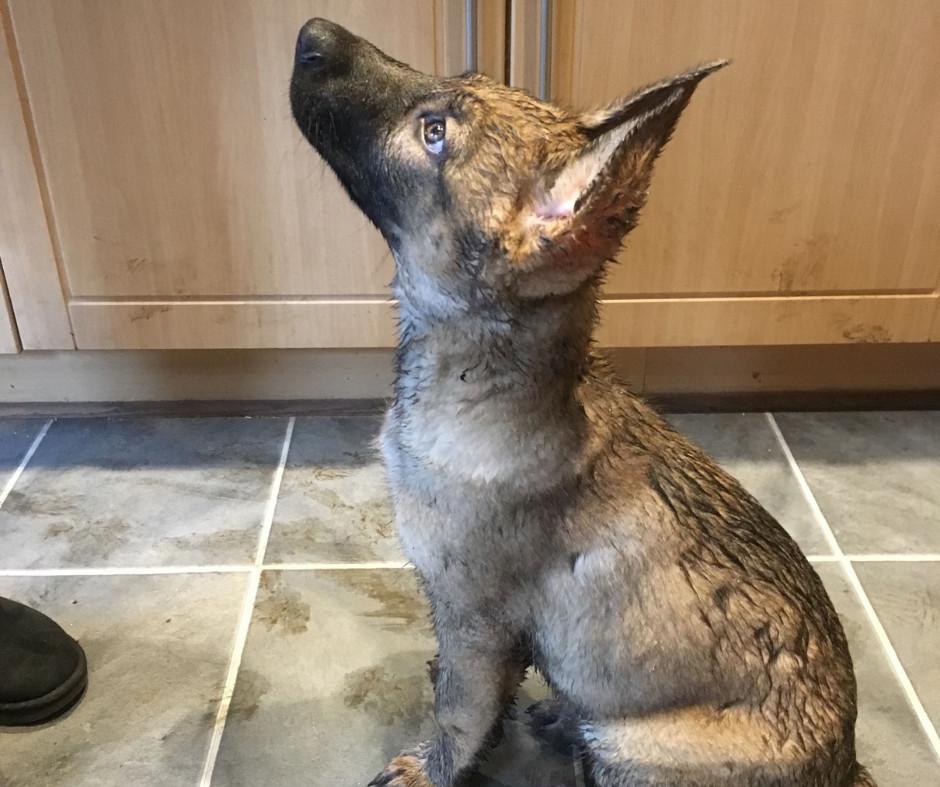
…. You get the idea
Responsible pet ownership includes effective waste management. Poop bags and clean-up supplies are essential to maintain cleanliness in and around your home and in public spaces. Regularly cleaning up after your puppy is considerate to others and helps prevent the spread of diseases.
Opt for eco-friendly poop bag options to minimise your environmental footprint. Biodegradable bags break down more quickly in landfills, reducing their environmental impact.

They are available in most pet stores on convenient rolls, which are ideal to keep in your pocket while walking.
If you can’t get hold of any, then nappy or diaper bags are just as good. You want to avoid bags with little air holes for obvious reasons.
A pooper scooper may come in handy, too, if you don’t like the idea of picking it up directly into the bag.
To further understand the importance of responsible waste management and eco-friendly options, visit Earth911’s guide on eco-friendly pet waste disposal for sustainable solutions.
Incorporating these essential supplies and strategies ensures that your German Shepherd puppy experiences a safe, comfortable, and nurturing home environment.
A well-structured living space contributes to their well-being, making your journey smoother and more enjoyable. Remember, a content and secure puppy is more likely to thrive and become a cherished family member.
Toys, Food, and Grooming
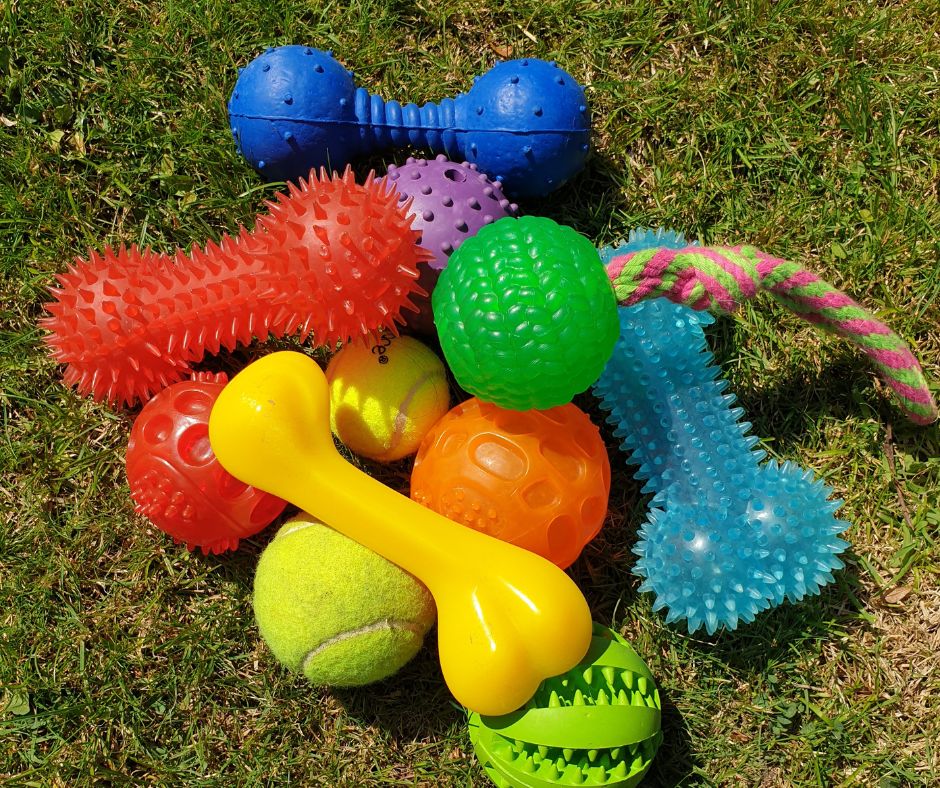
Embarking on the delightful journey of raising a German Shepherd puppy requires ensuring they have appropriate toys, nourishment, and grooming care. These elements contribute not only to their physical well-being but also to their mental and emotional development.
In this section, we’ll delve into the world of toys, food, and grooming supplies that will make your puppy’s life wholesome and enriching.
Choosing the Right Toys
Play is an integral part of a puppy’s development, fostering cognitive growth, physical fitness, and emotional bonding. Choosing the right toys keeps your puppy entertained and helps alleviate teething discomfort and destructive behaviours.
Opt for durable toy options that can withstand the robust playstyle of German Shepherds. Toys like Kong Classic rubber and puzzle toys engage their intellect and offer hours of entertainment.
Food and Water Bowls
Selecting appropriate food and water bowls is essential for your puppy’s daily nourishment. Opt for bowls made of non-toxic materials, like stainless steel or ceramic, to ensure your puppy’s safety.
German Shepherds are a deep-chested breed, which makes them prone to bloat. Consider using elevated bowls that promote slower eating and better digestion to minimise the risk.
Tip:
Avoid buying plastic bowls, which was my mistake when purchasing bowls for my German Shepherd puppy Bella. Believe me, plastic bowls and German Shepherd puppies are not a good combination as they don’t stay as bowls very long.
Selecting Puppy Food

Choosing the right puppy food is pivotal for your furry friend’s growth and health. Maintaining a consistent diet that caters to their specific nutritional needs is crucial during this critical development phase.
You must feed quality puppy food to give your puppy the best start in life. Puppies need a higher fat content in their diet than adult dogs, so make sure you also feed a food appropriate to your puppy’s age.
Look for high-quality puppy food that lists meat as the primary ingredient and avoids artificial additives. Ask the breeder which food your puppy has been eating and get a good supply of this to start with. You don’t have to continue feeding it, but you must gradually introduce any new food you decide to feed over 7 days to avoid digestive issues.
Transitioning to New Food
| Day | Old Food | New Food |
|---|---|---|
| 1 | 6/7 | 1/7 |
| 2 | 5/7 | 2/7 |
| 3 | 4/7 | 3/7 |
| 4 | 3/7 | 4/7 |
| 5 | 2/7 | 5/7 |
| 6 | 1/7 | 6/7 |
| 7 | 0/7 | 7/7 |
| 8 | – | 100% |
Many breeders will give you a bit of food to see you over a few meals, but it is worth giving them a call in advance to ensure you can get some.
For guidance on puppy feeding, refer to the American Kennel Club’s guide on choosing puppy food for insights from a reputable source.
Treats for Training
Treats play a pivotal role in training your German Shepherd puppy. They serve as positive reinforcement, motivating your puppy to learn new commands and behaviours. However, choosing treats wisely is essential to ensure they are nutritious and beneficial for your puppy’s health.
Opt for recommended treat options that are both tasty and healthy. Treats should be small and easy to chew, especially during training sessions.
Grooming Supplies
Grooming is an essential aspect of German Shepherd care, contributing to their health and appearance. Regular grooming keeps their coat clean and shiny and strengthens the bond between you and your puppy.
Some essential grooming tools for German Shepherds include a slicker brush for removing loose fur, an undercoat rake for managing shedding, and a nail clipper to maintain paw health.
However, when you first get your puppy, it won’t have developed its German Shepherd coat yet, so it’s essential to be gentle. Get a soft-bristled puppy brush and some puppy-friendly shampoo, then progress to the other brushes when their coat matures.
Establishing a regular grooming routine is crucial for coat maintenance. Brush them at least once a week to prevent mats and promote healthy skin.
By ensuring your German Shepherd puppy has access to the right toys, nourishment, and grooming care, you’re paving the way for a healthy and fulfilling life together.
These supplies contribute to their holistic development and well-being, ensuring your bond with your furry companion grows stronger each day. Remember, a well-cared-for puppy is a happy and content member of your family.
Puppy Health, and Pet Insurance

In the realm of German Shepherd puppy care, ensuring their health and providing financial security through insurance is paramount. This section dives into the essential aspects of health considerations, preventive care, and the crucial significance of pet insurance.
Health Considerations
Health considerations are of utmost importance to ensure the well-being of your German Shepherd puppy. Being aware of potential health issues specific to the breed can help you take proactive steps to prevent and manage them effectively. Here are some common health concerns that require attention:
Hip and Elbow Dysplasia:
This genetic condition is prevalent among German Shepherds and occurs when the hip or elbow joints don’t develop properly. It has the potential to cause pain, lameness, and reduced mobility. Regular exercise, ensuring a healthy weight, and offering joint supplements can aid in managing the condition and ease any discomfort.
Gastrointestinal Issues:
German Shepherds can be sensitive to certain foods, making them prone to gastrointestinal problems such as diarrhoea and upset stomach. Opting for high-quality, easily digestible puppy food and avoiding sudden diet changes can help prevent these issues.
Skin Problems and Allergies:
Skin conditions and allergies can affect your puppy’s comfort and quality of life. German Shepherds are susceptible to allergies caused by environmental factors, food, or parasites. Regular grooming, using hypoallergenic products, and keeping an eye out for signs of itching, redness, or hair loss can help manage skin problems.
Bloat (Gastric Dilatation-Volvulus):
Bloat, a life-threatening condition, can impact deep-chested breeds such as German Shepherds. This situation arises when the stomach becomes filled with gas and undergoes a twist, obstructing blood flow. Symptoms include restlessness, pacing, drooling, and an enlarged abdomen. Immediate veterinary attention is crucial to save your puppy’s life.
Degenerative Myelopathy:
This advancing neurological ailment impacts the spinal cord and hind limbs, resulting in difficulties with mobility. While there’s no cure, early detection and management through exercise, physical therapy, and supportive care can help improve your puppy’s quality of life.
My first German Shepherd, Sasha, had this condition. We enhanced her quality of life with a set of wheels, giving her a new lease of life. She lived to be almost 15 years old.
Exocrine Pancreatic Insufficiency (EPI):
My male dog, Cody, was diagnosed with EPI at the age of 2. It is a condition where the pancreas fails to produce enough digestive enzymes. It can result in weight loss, diarrhoea, and malnutrition. Treatment involves enzyme replacement therapy and a specialised diet.
Regular veterinary check-ups are vital for closely monitoring your puppy’s health and identifying potential issues at an early stage. Additionally, implementing preventive care measures, such as vaccinations, parasite control, dental care, and a balanced diet, can contribute to your puppy’s overall health and longevity.
For comprehensive insights into German Shepherd health concerns and preventive care, refer to the American Kennel Club’s German Shepherd health guide.
By staying informed about these health considerations and proactively addressing them, you ensure that your German Shepherd puppy enjoys a healthy, happy, and fulfilling life by your side.
Importance of Pet Insurance
Do not overlook pet insurance, as it is a crucial safety net. Unexpected medical expenses can arise, and insurance ensures your puppy receives the care they deserve without the added financial strain. The significance of pet insurance includes the following:
| Financial Preparedness: | Overing medical emergencies, surgeries, and treatments to alleviate financial burdens. |
| Peace of Mind: | Knowing you can provide top-notch care in emergencies or unexpected health issues. |
Your vet may be able to assist you in finding an appropriate insurance policy.
By prioritising health considerations and embracing pet insurance, you’re taking proactive steps to secure your German Shepherd’s health and well-being. Providing the best care possible contributes to a fulfilling and harmonious life together.
Behavioural Tips: Nurturing Your German Shepherd’s Well-Rounded Development
Beyond the physical well-being of your German Shepherd puppy, their behavioural development is equally crucial for a harmonious and fulfilling companionship. Here are some essential behavioural tips to guide you in fostering a well-rounded and well-behaved furry friend:
Socialisation Matters
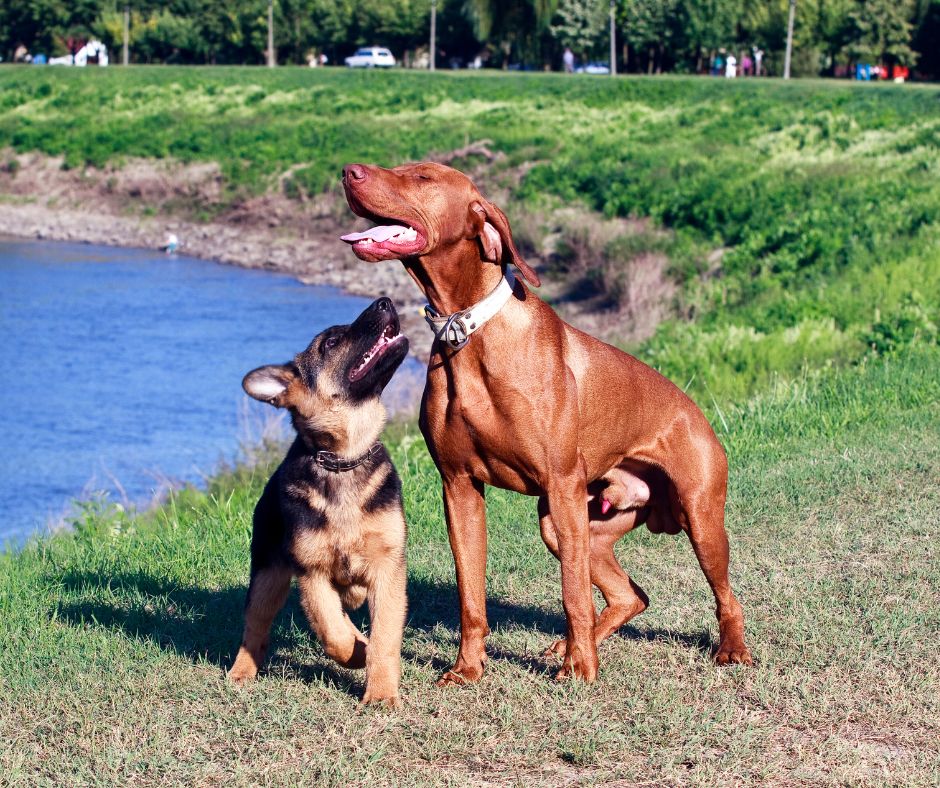
Initiating early and positive socialisation plays a pivotal role in aiding your puppy’s development into a self-assured and well-adapted adult. Introduce them to various people, animals, environments, and experiences to build their comfort and adaptability.
Training for Activities
Engage your German Shepherd puppy in specific training activities that align with their natural instincts and intelligence. Activities like agility training, scent work, and obedience training keep them mentally stimulated and strengthen the bond between you and your puppy.
Preventing Separation Anxiety
German Shepherds are known for their loyalty, which can sometimes lead to separation anxiety. Gradually accustom your puppy to being alone for short periods, use comforting toys, and avoid making departures and returns overly dramatic.
Positive Reinforcement
Utilise positive reinforcement techniques during training. Reward good behaviour with treats, praise, and play to encourage desired actions and responses.
Consistency and Patience
Maintaining consistency is essential in terms of training and behavioural advancement. Be patient with your puppy, and remember that it takes time for them to learn and understand your expectations.
Exercise and Mental Stimulation
German Shepherds thrive on physical and mental challenges. Regular exercise and engaging activities, such as puzzle toys and interactive games, keep their minds and bodies active and prevent boredom.
Bonding Time
Spend quality time with your puppy to foster a strong bond. Engage in activities you both enjoy, whether exploring the outdoors, playing fetch, or simply relaxing together.
Incorporating these behavioural tips into your German Shepherd puppy’s routine sets the stage for a well-behaved, confident, and joyful companion. Remember that every puppy is unique, and tailoring your approach to their personality and needs will create a lasting and fulfilling relationship.
Addressing Common Challenges: Navigating the Ups and Downs
Raising a German Shepherd puppy comes with its share of challenges, but with the right strategies and patience, you can overcome them and create a harmonious living environment. Here are some common challenges you might encounter and tips for handling them:
Crate Training Difficulties
Some puppies may initially resist crate training. To overcome this, make the crate a positive space by placing treats, toys, and comfortable bedding inside. Gradually increase crate time, ensuring your puppy associates it with positive experiences.
Teething Troubles
Teething can lead to discomfort and excessive chewing. Provide appropriate teething toys to soothe their gums. Redirect inappropriate chewing to toys and reinforce good behaviour with praise and rewards.
Excessive Energy
German Shepherds are energetic breeds that require plenty of physical and mental stimulation. Ensure they receive regular exercise and engage in activities that challenge their minds to prevent boredom and undesirable behaviours.
Leash Reactivity
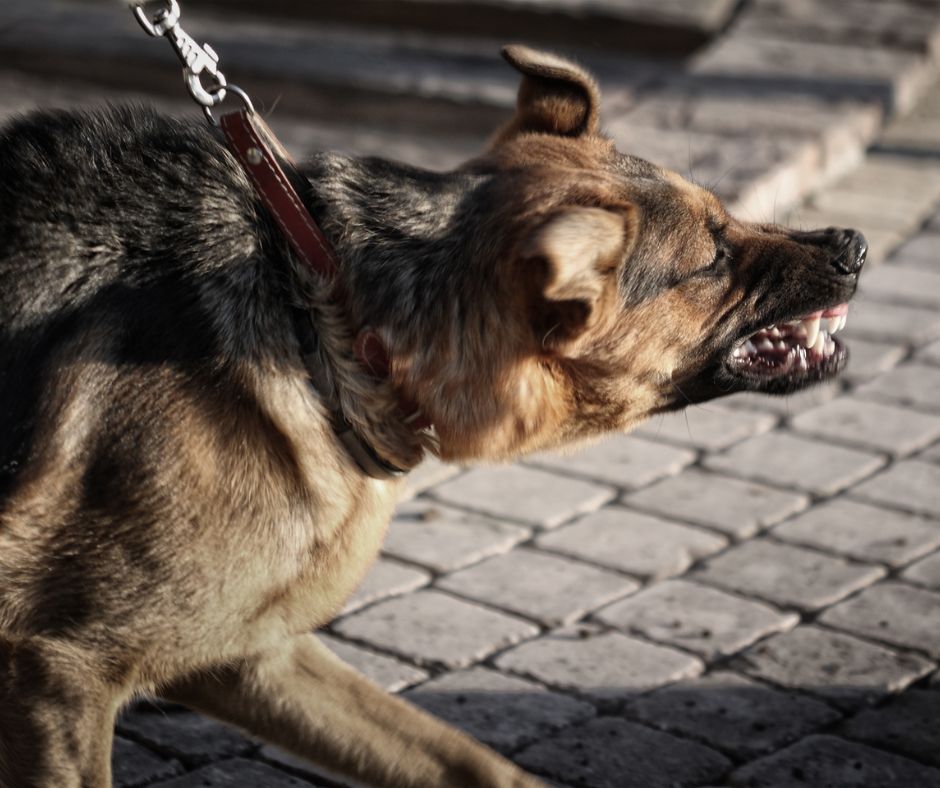
Some German Shepherds may exhibit leash reactivity towards other dogs or people. Socialise your puppy early and practice positive reinforcement training to encourage calm behaviour on walks.
Separation Anxiety
Due to their strong bonds, German Shepherds are susceptible to experiencing separation anxiety when left alone. Gradually increase alone time, provide interactive toys, and consider crate training to ease their anxiety.
Housebreaking Challenges
Accidents are normal during housebreaking. Establish a consistent routine, reward outdoor potty breaks, and supervise your puppy closely indoors. Clean accidents with an enzymatic cleaner to eliminate odours.
Nipping and Mouthing
Puppies explore the world with their mouths, but nipping can become problematic. Teach bite inhibition through gentle corrections and withdrawing attention when biting occurs.
Jumping Up
German Shepherds are enthusiastic and may jump up on people. Teach them the “off” command and reward them for keeping all four paws on the ground.
Barking Behaviour
Boredom, alertness, or anxiety can trigger excessive barking. Identify and address the cause through training, exercise, and mental stimulation.
Counter Surfing
Some German Shepherds may be prone to counter-surfing for food. Keep countertops clear of tempting items, and train your puppy to stay away from the kitchen area.
Remember, each puppy is unique, and challenges may vary. Consistency, positive reinforcement, and patience are your greatest allies in overcoming these challenges. Seeking guidance from experienced trainers or behaviourists can provide additional support in managing specific issues.
With dedication and a willingness to adapt, you’ll navigate these challenges and create a well-balanced and enjoyable life with your German Shepherd puppy.
FAQs: German Shepherd Puppy Supplies
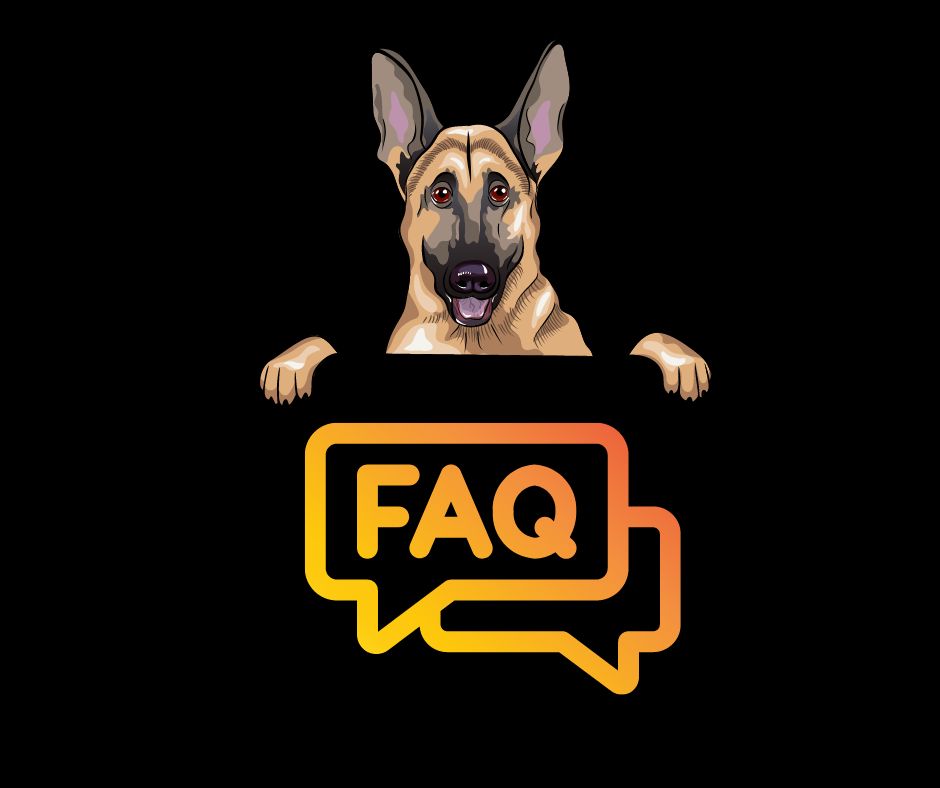
How do I choose the right size collar for my German Shepherd puppy?
Measure your puppy’s neck and add a few inches for adjustment. Select a collar that fits securely without being overly tight.
Are there specific toys that are suitable for teething puppies?
Yes, soft and durable toys designed for teething can soothe your puppy’s gums and satisfy their chewing instincts.
Should I opt for a traditional leash or a retractable one?
Using a traditional leash is recommended for training and control purposes. Retractable leashes offer less control and can be unsafe in certain situations.
What type of crate is best for crate training a German Shepherd?
Choose a sturdy, well-ventilated crate large enough for your puppy to stand, turn, and lie down comfortably.
How often should I groom my German Shepherd puppy?
Brush your puppy’s coat at least once a week and bathe as needed. Regular grooming prevents mats and promotes healthy skin.
Is it necessary to use a slow feeder bowl for my puppy?
Slow feeder bowls can prevent fast eating and reduce the risk of bloating, making them a beneficial choice for deep-chested breeds like German Shepherds.
When should I start leash training my German Shepherd puppy?
Begin leash training as early as 8 to 10 weeks of age. Start with brief sessions and progressively extend the duration.
What health checks should I schedule for my puppy?
Schedule regular veterinary check-ups for vaccinations, parasite control, dental care, and monitoring overall health.
How do I properly introduce my puppy to a crate?
Make the crate a positive space with treats and toys. Gradually encourage your puppy to enter and spend short periods inside.
What should I consider when selecting puppy food?
Look for high-quality food with meat as the primary ingredient, avoiding artificial additives. Consult your veterinarian for specific recommendations.
Conclusion: Your German Shepherd’s Journey Begins Here
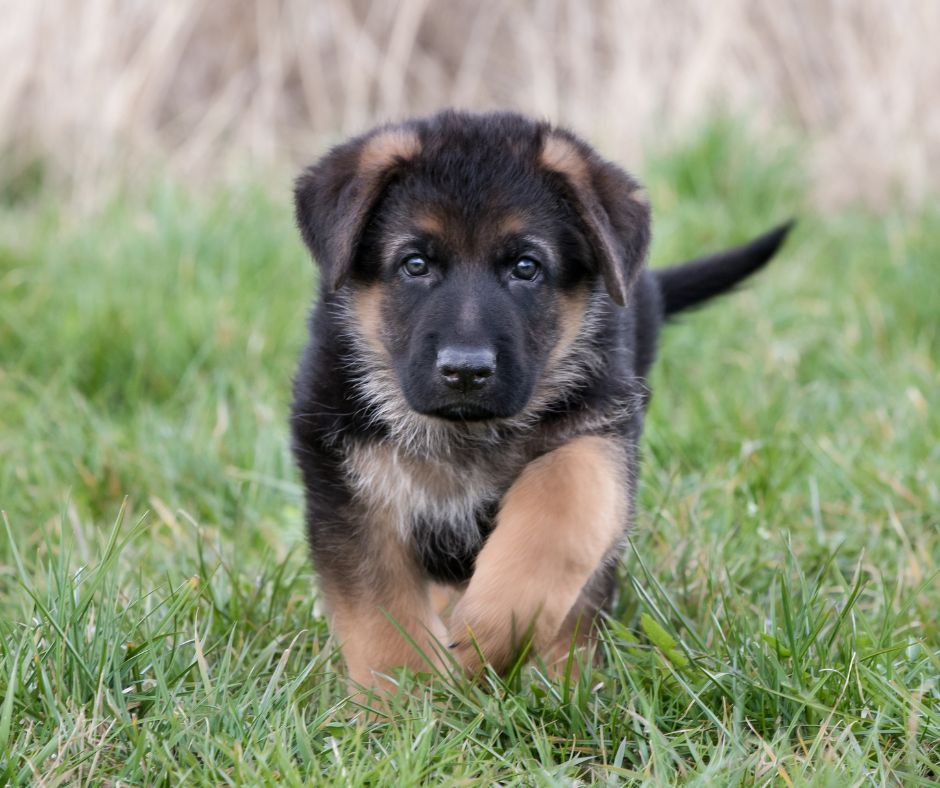
So as we wrap up this guide on German Shepherd puppy supplies, I would like to congratulate you again on embarking on the exciting adventure of raising a German Shepherd puppy!
I know you won’t be disappointed, and as you prepare to welcome your new furry companion into your home, remember that the right supplies and a well-equipped environment set the stage for a fulfilling and joyful journey.
By addressing essential health considerations and making thoughtful choices in toys, food, and grooming, you possess the knowledge to offer optimal care for your puppy’s growth and well-being.
By delving into this comprehensive guide on German Shepherd puppy supplies, you’ve gained insights into creating a safe, comfortable, and enriching space for your puppy to thrive. Whether choosing the correct collar size, selecting appropriate toys, or understanding the importance of pet insurance, your dedication to your puppy’s needs is commendable.
Join the Conversation: Sharing Your German Shepherd Supply Journey
I’d love to hear from you if you have any questions, thoughts, or experiences to share about German Shepherd puppy supplies. Leave a comment below to start a conversation and share your insights. Together, as a community of devoted German Shepherd enthusiasts, we can continue to support each other in providing the best for our four-legged companions.
Remember, your journey with your German Shepherd is unique, and every step you take brings you closer to creating a strong and lasting bond. Cherish every moment, and may your days be filled with wagging tails, joyful play, and unforgettable memories.
